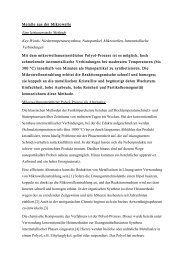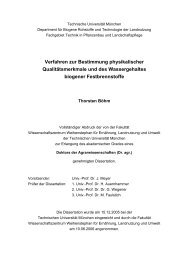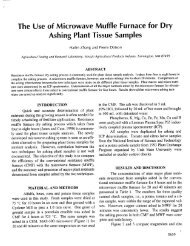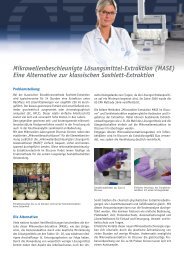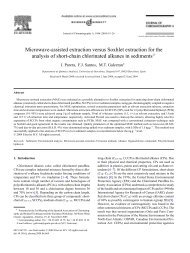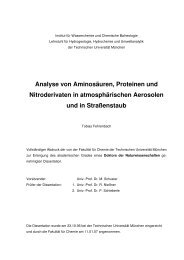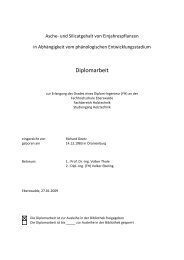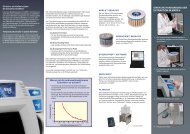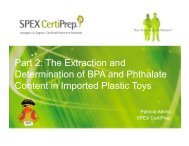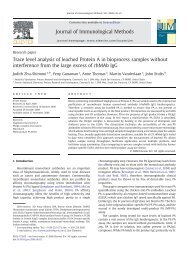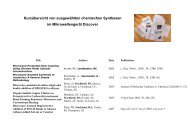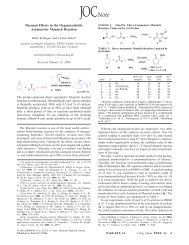COMMUNICATION Microwave synthesis and inherent stabilization ...
COMMUNICATION Microwave synthesis and inherent stabilization ...
COMMUNICATION Microwave synthesis and inherent stabilization ...
You also want an ePaper? Increase the reach of your titles
YUMPU automatically turns print PDFs into web optimized ePapers that Google loves.
Dalton<br />
Transactions<br />
Dynamic Article Links<br />
Cite this: Dalton Trans., 2011, 40, 8290<br />
www.rsc.org/dalton <strong>COMMUNICATION</strong><br />
<strong>Microwave</strong> <strong>synthesis</strong> <strong>and</strong> <strong>inherent</strong> <strong>stabilization</strong> of metal nanoparticles in<br />
1-methyl-3-(3-carboxyethyl)-imidazolium tetrafluoroborate<br />
Dorothea Marquardt, a Zailai Xie, b Andreas Taubert,* b,c Ralf Thomann d <strong>and</strong> Christoph Janiak* a<br />
Received 29th April 2011, Accepted 7th June 2011<br />
DOI: 10.1039/c1dt10795j<br />
The <strong>synthesis</strong> of Co–NPs <strong>and</strong> Mn–NPs by microwaveinduced<br />
decomposition of the metal carbonyls Co 2(CO) 8<br />
<strong>and</strong> Mn 2(CO) 10, respectively, yields smaller <strong>and</strong> better separated<br />
particles in the functionalized IL 1-methyl-3-(3-carboxyethyl)-imidazolium<br />
tetrafluoroborate [EmimCO 2H][BF 4]<br />
(1.6 ± 0.3 nm <strong>and</strong> 4.3 ± 1.0 nm, respectively) than in the nonfunctionalized<br />
IL 1-n-butyl-3-methylimidazolium tetrafluoroborate<br />
[Bmim][BF 4].Theparticlesarestableintheabsence<br />
of capping lig<strong>and</strong>s (surfactants) for more than six months<br />
although some variation in particle size could be observed by<br />
TEM.<br />
Metal carbonyls M x(CO) y 1 or other M(0) complexes 2 are interesting<br />
precursors for the <strong>synthesis</strong> of metal nanoparticles (M–NPs)<br />
because the metal atoms are already in their final zero-valent<br />
oxidation state. Thus, no reducing agent is necessary <strong>and</strong> the<br />
carbonyl (CO) side product is largely given off to the gas phase <strong>and</strong><br />
thereby removed from the M–NP dispersion. Contamination from<br />
by- or decomposition products which are otherwise generated<br />
during the M–NP <strong>synthesis</strong> are therefore significantly reduced<br />
<strong>and</strong> very clean particles can thus be obtained. 3<br />
The small size of nanoparticles results in a large fraction of<br />
surface atoms. 4 Unprotected small particles interact via van der<br />
Waals <strong>and</strong> (if the particles are magnetic) magnetic interactions<br />
which will lead to agglomeration or aggregation from the cohesive<br />
surface energy. 5 As a result of their colloidal instability, many<br />
nanoparticles need to be stabilized via additional (capping)<br />
agents such as surfactants or polymers, which provide a steric,<br />
electrostatic or electrosteric particle <strong>stabilization</strong>. 4,6<br />
Ionic liquids (ILs) can stabilize metal nanoparticles through<br />
their high ionic charge, their polarity <strong>and</strong> high dielectric<br />
constants. 7,8 ILs can therefore function both as stabilizer <strong>and</strong><br />
solvent for the preparation of small (< 5 nm) <strong>and</strong> (generally)<br />
kinetically stabilized M–NPs. 9,10 For these reasons, the chemistry<br />
of inorganic compounds <strong>and</strong> inorganic materials <strong>synthesis</strong> in<br />
a Institut für Anorganische Chemie und Strukturchemie, Universität<br />
Düsseldorf, Universitätsstr. 1, D-40225, Düsseldorf. E-mail: janiak@<br />
uni-duesseldorf.de; Tel: +49 (0)211 81 12286<br />
b Institute of Chemistry, University of Potsdam, D-14476, Golm, Germany.<br />
E-mail: ataubert@uni-potsdam.de; Tel: +49 (0)331 977 5773<br />
c Max Planck Institute of Colloids <strong>and</strong> Interfaces, D-14476, Golm, Germany<br />
d Freiburger Material Forschungszentrum (FMF), Universität Freiburg,<br />
Stefan-Meier-Str., 21-31, 79104, Freiburg, Germany<br />
ILs 11,12 <strong>and</strong> ionic liquid crystals (ILCs) 13,14 has attracted tremendous<br />
interest in the recent past.<br />
A scientifically interesting <strong>and</strong> technologically promising approach<br />
is the preparation <strong>and</strong> <strong>stabilization</strong> of M–NPs from<br />
metal carbonyls in ILs. 3,15 The <strong>stabilization</strong> of M–NPs in nonfunctionalized<br />
ILs such as 1-butyl-3-methylimidazolium tetrafluoroborate<br />
[Bmim][BF 4] is primarily based on the IL-anions, which<br />
form the immediate layer around the nanoparticle because the<br />
molecular volume of the IL anion influences sizes <strong>and</strong> shapes<br />
of the resulting metal nanoparticles. 3,10,16,17 Functional amino-, 18<br />
carboxylic acid-, 19 hydroxyl-, 20 nitrile- 21 or thiol-, 22 groups on the<br />
imidazolium cations exert an additional <strong>stabilization</strong> on M–NPs<br />
because of specific interactions of the functional group with the<br />
particle surface. The donor atom(s) of the functional group can<br />
attach to the metal nanoparticle much like an extra stabilizing<br />
capping lig<strong>and</strong>. 19 Then, the <strong>stabilization</strong> of metal-nanoparticles in<br />
functionalized-imidazolium-based ILs occurs through the cation<br />
with its functional group (Fig. 1). 11,23 For both non-functionalized<br />
<strong>and</strong> functionalized ILs equally charged layers around the M–NPs<br />
lead to their separation through electrostatic repulsion <strong>and</strong>, thus,<br />
prevent their aggregation or Ostwald ripening. 24<br />
Fig. 1 Three possible <strong>stabilization</strong> modes of metal-nanoparticles by<br />
IL-imidazolium cations with functional groups (FG).<br />
Here we present a simple <strong>synthesis</strong> method for cobalt <strong>and</strong><br />
manganese nanoparticles (Co–NPs <strong>and</strong> Mn–NPs) from their<br />
metal-carbonyl precursors Co 2(CO) 8 <strong>and</strong> Mn 2(CO) 10, respectively,<br />
in the carboxylic acid functionalized imidazolium ionic liquid<br />
(IL) 1-methyl-3-(3-carboxyethyl)-imidazolium tetrafluoroborate<br />
[EmimCO 2H][BF 4], under microwave irradiation (MWI) (Fig.<br />
2).† The results show that the additional carboxylic acid on the IL<br />
(Fig. 3) does in both cases (Mn <strong>and</strong> Co) lead to a more uniform<br />
product <strong>and</strong> a better <strong>stabilization</strong> of the nanoparticles. Co– <strong>and</strong><br />
Mn–NPs can be used as catalysts for Fischer–Tropsch reactions<br />
(Co–NPs also prepared from Co 2(CO) 8) 25 <strong>and</strong> in the reduction of<br />
polycyclic aromatic hydrocarbons <strong>and</strong> heterocyclic hydrocarbons<br />
(Mn <strong>and</strong> Co). 26<br />
8290 | Dalton Trans., 2011, 40, 8290–8293 This journal is © The Royal Society of Chemistry 2011
Fig. 2 Formation of Co <strong>and</strong> Mn nanoparticles by microwave irradiation-induced<br />
decomposition of metal carbonyls M x(CO) y under argon in<br />
ILs.<br />
Fig. 3 Chemical structure of the ILs relevant in this study.<br />
ILs are attractive media for microwave reactions because of<br />
their high interaction cross-section resulting from their high ionic<br />
charge, high polarity, <strong>and</strong> high dielectric constant. 1,27 Fig. 4 shows<br />
representative transmission electron microscopy (TEM) images of<br />
the nanoparticles obtained from the decomposition of Co 2(CO) 8 in<br />
[EmimCO 2H][BF 4] <strong>and</strong> [Bmim][BF 4]. Small Co–NPs with narrow<br />
size distribution are reproducibly obtained from Co 2(CO) 8 by<br />
microwave irradiation in the functionalized IL [EmimCO 2H][BF 4]<br />
(Fig. 4). All samples grown in [EmimCO 2H][BF 4] contain small<br />
<strong>and</strong> monodisperse particles with a diameter of 1.6 ± 0.3 nm. Six<br />
months after <strong>synthesis</strong> the particle size has increased to 3.0 ±<br />
0.6 nm; the size distribution is still narrow. In contrast, Co–NPs<br />
synthesized from Co 2(CO) 8 under the same conditions, but in<br />
the non-functionalized IL [Bmim][BF 4] exhibit larger, relatively<br />
highly aggregated nanoparticles of 5.1 ± 0.9 nm in diameter with<br />
somewhat irregular shapes. 15<br />
The sample identity <strong>and</strong> crystallinity can be evaluated from<br />
selected area electron diffraction (SAED). SAED patterns do<br />
not show reflections indicative of a crystalline material. We<br />
therefore conclude that the particles obtained from the <strong>synthesis</strong><br />
are amorphous Co–NPs stabilized by the IL.<br />
Fig. 5 shows representative TEM data of the nanoparticles<br />
obtained from the decomposition of Mn 2(CO) 10 in<br />
[EmimCO 2H][BF 4] <strong>and</strong> [Bmim][BF 4]. The Mn–NPs are larger<br />
than the Co–NPs <strong>and</strong> have a diameter of 4.3 ± 1.0 nm. The<br />
nucleation rate (possibly controlled by the decomposition rate of<br />
the carbonyl) may be different for the two precursors. Thus, if the<br />
two carbonyls decompose at different rates, the supersaturation<br />
will not be the same <strong>and</strong> consequently, the particle number will<br />
not be identical. If we have a fast decomposition, more <strong>and</strong> smaller<br />
particles may form, if the decomposition is slower, we may generate<br />
larger particles. Still, the small particle sizes <strong>and</strong> the narrow size<br />
distribution for Mn–NPs are remarkable because under the same<br />
conditions in [Bmim][BF 4] the particle diameter is 28.6 ± 11.5<br />
nm. Again, SAED shows that the Mn-particles obtained in the<br />
microwave process are amorphous <strong>and</strong> remain so over time.<br />
Interestingly, TEM images of Mn–NPs in [EmimCO 2H][BF 4]<br />
stored under nitrogen atmosphere show a decrease of the NP sizes<br />
to 2.4 ± 0.5 nm with prolonged storage of the NP dispersion.<br />
Such a decrease in size is counter-intuitive to the expected slow<br />
aggregation or growth of kinetically stabilized small (< 5 nm)<br />
metal nanoparticles. With the good coordinating ability of the<br />
Fig. 4 (a) TEM-images of Co–NPs in [EmimCO 2H][BF 4] six weeks after<br />
<strong>synthesis</strong>; (b) SAED-image of Co–NPs (the black bar in the SAED is<br />
the beam stopper) indicating amorphous material (no well-defined sharp<br />
reflections). (c) TEM of Co–NPs in [EmimCO 2H][BF 4] 6 months after<br />
<strong>synthesis</strong>; (d) SAED of Co–NPs in [EmimCO 2H][BF 4] after 6 months,<br />
still indicating an amorphous material; (e) Co–NPs from Co 2(CO) 8 in<br />
[Bmim][BF 4].<br />
carboxylate group some chemical etching of the M–NPs by the<br />
IL may be possible. Binnemans et al. use the metal-complexforming<br />
abilities of ILs with carboxyl-functionalized cations<br />
for the dissolution of metal oxides <strong>and</strong> metal hydroxides in<br />
carboxylated ILs. The carboxylic acid moiety provides this class<br />
of ILs with a good solubilizing ability for basic metal oxides <strong>and</strong><br />
metal hydroxides leading to molecular metal-carboxylate species<br />
in such functionalized ILs. 28,29 The main difference between the<br />
current work <strong>and</strong> the Binnemans study is that in the earlier case,<br />
the oxidation state of the metals is positive <strong>and</strong> the reaction leading<br />
to the complexes is an acid–base reaction. In the current case<br />
we suspect that a slow redox reaction between reactive surface<br />
metal atoms <strong>and</strong> carboxylic acid yields some molecular metalcarboxylate<br />
complexes <strong>and</strong> H 2, effectively leading to a reduced<br />
particle size after a few months. A reason for the selectivity of this<br />
process (towards Mn– <strong>and</strong> not Co–NPs) could be the less-noble<br />
character of the former (st<strong>and</strong>ard reduction potentials Mn 2+ /Mn =<br />
-1.18 V, Co 2+ /Co =-0.28 V, both in acidic aqueous solution). 30<br />
This journal is © The Royal Society of Chemistry 2011 Dalton Trans., 2011, 40, 8290–8293 | 8291
Fig. 5 (a) TEM-image of Mn–NPs in [EmimCO 2H][BF 4] six weeks after<br />
<strong>synthesis</strong>; (b) SAED-image of Mn–NP (the black bar in the SAED is<br />
the beam stopper) indicating amorphous material (no well-defined sharp<br />
reflections). (c) TEM of Mn–NPs in [EmimCO 2H][BF 4] six months after<br />
<strong>synthesis</strong>; (d) SAED of Mn–NPs in [EmimCO 2H][BF 4] after 6 months,<br />
still indicating an amorphous material; (e) Mn–NPs from Mn 2(CO) 10 in<br />
[Bmim][BF 4].<br />
As the energy input in the nanoparticle <strong>synthesis</strong> is rather<br />
low (<strong>and</strong> hence some metal carbonyl may survive the reaction),<br />
complete decomposition of the metal carbonyl was ascertained by<br />
attenuated total reflection infrared (ATR-IR) spectroscopy.‡ Fig.<br />
6 compares ATR-IR spectra of the freshly prepared carbonyl/IL<br />
dispersion <strong>and</strong> of the reaction mixture after microwave treatment.<br />
The spectra of the initial metal carbonyl/IL dispersion show<br />
the typical b<strong>and</strong> structure of metal carbonyls (2002 cm -1 <strong>and</strong><br />
1810 cm -1 for terminal <strong>and</strong> bridging CO lig<strong>and</strong>s, respectively,<br />
in Co 2(CO) 8 <strong>and</strong> 2011 cm -1 <strong>and</strong> 1943 cm -1 for the terminal CO<br />
lig<strong>and</strong>s in Mn 2(CO) 10). These b<strong>and</strong>s disappeared after microwave<br />
treatment. ATR-IR spectroscopy thus indicates that the metal<br />
carbonyl precursors are completely decomposed after irradiation<br />
for6minwith20W.<br />
The use of a carboxylic acid-functionalized IL has already<br />
been described for the <strong>synthesis</strong> of Pt(0) <strong>and</strong> Au(0) nanoparticles<br />
from H 2PtCl 6 <strong>and</strong> HAuCl 4 by reduction with NaBH 4 in aqueous<br />
solution. Particle sizes of 2.5 ± 0.5 nm (Pt) <strong>and</strong> 3.5 ± 1.0 nm<br />
(Au) were obtained. 19 The IL used in this previous study, 1carboxymethyl-3-methylimidazolium<br />
chloride, is quite similar to<br />
Fig. 6 ATR-IR spectra of (a) Co 2(CO) 8/IL (gray curve) <strong>and</strong> the resulting<br />
Co–NP (0.5 wt.%)/IL-dispersion after microwave treatment <strong>and</strong> of (b)<br />
Mn 2(CO) 10/IL (gray curve) <strong>and</strong> Mn–NP (0.5 wt.%)/IL after microwave<br />
treatment (20 W, 6 min).<br />
the one used in the current work, but it was significantly more<br />
hydrophilic <strong>and</strong> contained a coordinating anion. The effect of the<br />
carboxylic acid functionalization could not clearly be discerned<br />
because the chloride anions also have a pronounced <strong>stabilization</strong><br />
effect towards nanoparticles, in particular towards Au–NPs 10 <strong>and</strong><br />
no comparison to a non-functionalized IL was made.<br />
The main finding of the current work is that carboxylated<br />
ILs can also be efficient reaction media <strong>and</strong> stabilizers if used<br />
as pure phases <strong>and</strong> not in aqueous solution. In particular the<br />
acidic group appears to lead to a well-controlled nucleation <strong>and</strong><br />
growth process, which is illustrated by the narrow size distribution<br />
of the resulting particles. Moreover, the carboxylic acid moiety<br />
stabilizes the particles over extended periods of time, which (1)<br />
is an indication of a rather strong interaction of the IL with the<br />
nanoparticles <strong>and</strong> (2) is useful for practical applications, such as<br />
functional fluids. An intriguing feature is the size decrease of the<br />
Mn–NPs with time, but, as pointed out above, this could be due<br />
to a surface redox process between the NP <strong>and</strong> the acid group. A<br />
more detailed investigation of this process is, however, necessary<br />
to conclude on the details of the process.<br />
8292 | Dalton Trans., 2011, 40, 8290–8293 This journal is © The Royal Society of Chemistry 2011
Acknowledgements<br />
Financial support by the University of Potsdam, through DFG<br />
grant Ja466/17-1, the Fonds der Chemischen Industrie, <strong>and</strong> the<br />
MPI of Colloids <strong>and</strong> Interfaces (Colloid Chemistry Department),<br />
is gratefully acknowledged. Z.L.X. acknowledges a Chinese<br />
Science Council Doctoral Fellowship.<br />
Notes <strong>and</strong> references<br />
† Experimental: Materials. Co 2(CO) 8 <strong>and</strong> Mn 2(CO) 10 were obtained<br />
from Acros Organics, [Bmim][BF 4] from IoLiTec. 1-methylimidazole, 3chloropropionic<br />
acid, <strong>and</strong> NaBF 4 were used as received from Acros.<br />
[EmimCO 2H][BF 4] Synthesis. Under an inert nitrogen atmosphere,<br />
equimolar quantities of 1-methylimidazole <strong>and</strong> 3-chloropropionic acid<br />
were dissolved in methanol at room temperature. The mixtures were heated<br />
to 75 ◦ C with stirring <strong>and</strong> allowed to react for 20 h. The resulting reaction<br />
mixture was treated with NaBF 4 (1.2 equiv) <strong>and</strong> allowed to stir for 18 h at<br />
room temperature. After separating the NaCl precipitant, the filtrate was<br />
concentrated by rotary evaporation. The yellow <strong>and</strong> viscous product was<br />
washed with diethyl ether <strong>and</strong> dried under vacuum to afford the neat IL.<br />
1 HNMR(D2O, ppm relative to TMS): 8.61 (s, 1H), 7.42 (d, 1H), 7.50<br />
(d, 1H), 4.22 (t, 2H), 3.83 (s, 3H), 2.10 (t, 2H). 31 IR (ATR): 3568, 3160,<br />
3115, 2959, 1728, 1572, 1376, 1282, 1169, 1015, 846, 752 cm -1 . Elemental<br />
analysis: calc. for C 7H 11BF 4N 2O 2: C 34.74%, H 4.58%, N 11.58%. Found:<br />
C 34.39%, H 4.60%, N 11.64%. Total yield: 68%.<br />
Nanoparticle <strong>synthesis</strong>. <strong>Microwave</strong> vials with a teflon septum were used.<br />
They were charged with ILs <strong>and</strong> metal-carbonyls by placing the vial in<br />
a Schlenck tube or by h<strong>and</strong>ling in a glovebox. The general procedure<br />
for preparing an 0.5 wt% M–NP dispersion in [EmimCO 2H][BF 4]wasto<br />
add the required mass of metal carbonyl [M x(CO) y,M= Mn 26.80 mg;<br />
Co 21.80 mg) under nitrogen to the dried <strong>and</strong> degassed IL (0.5 ml, 0.75<br />
g, density 1.51 g mL -1 ). A 0.5 wt% dispersion of M–NP in [Bmim][BF 4]<br />
was prepared by adding the required mass of metal carbonyl [M x(CO) y,<br />
M = Mn 21.30 mg; Co 17.40 mg) under nitrogen to the dried <strong>and</strong><br />
degassed IL (0.5 ml, 0.6 g, density 1.20 g mL -1 ). The metal carbonyls<br />
were finely dispersed in the ILs by stirring for 3 d at room temperature<br />
under nitrogen. The magnetic stir bars were removed from the dispersion<br />
<strong>and</strong> the reaction mixture was subsequently heated to 250 ◦ C (20 W, 6 min)<br />
by microwave irradiation (MWI, CEM Discover). Dark brown to black<br />
metal nanoparticle dispersions were obtained. They were degassed under<br />
reduced pressure for 30 min to remove CO.<br />
‡ Characterization. ATR-IR-spectroscopy was carried out on a Shimadzu<br />
IRAffinity equipped with a ZnSe crystal. TEM images were taken at room<br />
temperature on a Zeiss LEO 912 TEM operating at an accelerating voltage<br />
of 120 kV. Samples were deposited on 200 mm carbon-coated copper grids.<br />
1 C. Vollmer <strong>and</strong> C. Janiak, Coord. Chem. Rev., 2011,<br />
DOI: 10.1016/j.ccr.2011.03.005.<br />
2 M. H. G. Prechtl, P. S. Campbell, J. D. Scholten, G. B. Fraser, G.<br />
Machado, C. C. Santini, J. Dupont <strong>and</strong> Y. Chauvin, Nanoscale, 2010,<br />
2, 2601–2606.<br />
3 E. Redel, R. Thomann <strong>and</strong> C. Janiak, Chem. Commun., 2008, 1789–<br />
1791.<br />
4 S.Shylesh,V.Schünemann <strong>and</strong> W. Thiel, Angew. Chem., Int. Ed., 2010,<br />
49, 3428–3459.<br />
5 O. T. Mefford, M. L. Vadala, J. D. Goff, M. R. J. Caroll, R. Mejia-<br />
Ariza,B.L.Caba,T.G.St.Pierre,R.C.Woodward,R.M.Davis<strong>and</strong><br />
J. S. Riffle, Langmuir, 2008, 24, 5060–5069.<br />
6 D.Astruc,F.Lu<strong>and</strong>J.R.Aranzaes,Angew. Chem., Int. Ed., 2005, 44,<br />
7852–7872; C. Pan, K. Pelzer, K. Philippot, B. Chaudret, F. Dassenoy,<br />
P. Lecante <strong>and</strong> M.-J Casanove, J. Am. Chem. Soc., 2001, 123, 7584–<br />
7593; J. D. Aiken III <strong>and</strong> R. G. Finke, J. Am. Chem. Soc., 1999, 121,<br />
8803–8810.<br />
7 J. Dupont <strong>and</strong> J. D. Scholten, Chem.Soc.Rev., 2010, 39, 1780–1804;<br />
C. S. Consorti, P. A. Z. Suarez, R. F. de Souza, R. A. Burrow, D. H.<br />
Farrar, A. J. Lough, W. Loh, L. H. M. da Silva <strong>and</strong> J. Dupont, J. Phys.<br />
Chem. B, 2005, 109, 4341–4349; J. Dupont, J. Braz. Chem. Soc., 2004,<br />
15, 341–350.<br />
8 M.-A. Neouze, J. Mater. Chem., 2010, 20, 9593–9607.<br />
9 L. Durán Pachón <strong>and</strong> G. Rothenberg, Appl. Organomet. Chem., 2008,<br />
22, 288–299; A. Gual, C. Godard, S. Castillón <strong>and</strong> C. Claver, Dalton<br />
Trans., 2010, 39, 11499–11512.<br />
10 E. Redel, M. Walter, R. Thomann, C. Vollmer, L. Hussein, H. Scherer,<br />
M. Krüger <strong>and</strong> C. Janiak, Chem.–Eur. J., 2009, 15, 10047–10059; E.<br />
Redel, M. Walter, R. Thomann, L. Hussein, M. Krüger <strong>and</strong> C. Janiak,<br />
Chem. Commun., 2010, 46, 1159–1161.<br />
11 A. Taubert, Top. Curr. Chem., 2010, 290, 127–159.<br />
12 A. Taubert <strong>and</strong> Z. Li, Dalton Trans., 2007, 723–727; A. Taubert, Acta<br />
Chim. Slov., 2005, 52, 183–186; Z. Li, Z. Jia, Y. Luan <strong>and</strong> T. Mu, Curr.<br />
Opin. Solid State Mater. Sci., 2008, 12, 1–8.<br />
13 A. Taubert, Angew. Chem. Int. Ed., 2004, 43, 5380–5382; A. Taubert, P.<br />
Steiner <strong>and</strong> A. Mantion, J. Phys. Chem. B, 2005, 109, 15542–15547; A.<br />
Taubert, C. Palivan, O. Casse, F. Gozzo <strong>and</strong> B. Schmitt, J. Phys. Chem.<br />
C, 2007, 111, 4077–4082.<br />
14 W. Dobbs, J.-M. Suisse, L. Douce <strong>and</strong> R. Welter, Angew. Chem. Int.<br />
Ed., 2006, 45, 4179–4180; C. K. Lee, C. S. Vasam, W. T. Huang, J. M.<br />
H. Wang, Y. R. Yang, C. S. Lee <strong>and</strong> I. B. J. Lin, Organometallics, 2006,<br />
25, 3768–3775; J. M. Ma, X. D. Liu, J. B. Lian, X. C. Duan <strong>and</strong> W. J.<br />
Zheng, Cryst Growth Des., 2010, 10, 4668–4668.<br />
15 J. Krämer, E. Redel, R. Thomann <strong>and</strong> C. Janiak, Organometallics,<br />
2008, 27, 1976–1978; E. Redel, J. Krämer, R. Thomann <strong>and</strong> C. Janiak,<br />
J. Organomet. Chem., 2009, 694, 1069–1075; C. Vollmer, E. Redel, K.<br />
Abu-Sh<strong>and</strong>i, R. Thomann, H. Manyar, C. Hardacre <strong>and</strong> C. Janiak,<br />
Chem.Eur.J., 2010, 16, 3849–3858; D. Marquardt, C. Vollmer, R.<br />
Thomann, P. Steurer, R. Mülhaupt, E. Redel <strong>and</strong> C. Janiak, Carbon,<br />
2011, 49, 1326–1332.<br />
16 E. Redel, R. Thomann <strong>and</strong> C. Janiak, Inorg. Chem., 2008, 47, 14–16.<br />
17 V. Khare, Z. Li, A. Mantion, A. A. Ayi, S. Sonkaria, A. Voelkel, A. F.<br />
Thünemann <strong>and</strong> A. Taubert, J. Mater. Chem., 2010, 20, 1332–1339.<br />
18 R. Marcilla, D. Mecerreye, I. Odrizola, J. A. Pomposo, J. Rodriguez<br />
<strong>and</strong> I. Mondragon, Nano, 2007, 2, 169–173.<br />
19 H. Zhang <strong>and</strong> H. Cui, Langmuir, 2009, 25, 2604–2612.<br />
20 L. C. Branco, N. J. Rosa, J. J. Moura Ramos <strong>and</strong> C. A. M. Alfons,<br />
Chem.Eur.J., 2002, 8, 3671–3677.<br />
21 D. Zhao, Z. Fei, R. Scopelliti <strong>and</strong> P. Dyson, Inorg. Chem., 2004, 43,<br />
2197–2205; D. Zhao, Z. Fei, T. J. Geldbach, R. Scopeliti <strong>and</strong> P. Dyson,<br />
J. Am. Chem. Soc., 2004, 126, 15876–15882; M. H. G. Prechtl, J. D:<br />
Scholten <strong>and</strong> J. Dupont, J. Mol. Catal. A, 2009, 313, 74–78.<br />
22 H. Itoh, K. Naka <strong>and</strong> Y. Chujo, J Am. Chem. Soc., 2004, 126, 3026–<br />
3027.<br />
23 D.-P. Liu, G.-D. Li, Y. Su <strong>and</strong> J.-S. Chen, Angew. Chem. Int. Ed., 2006,<br />
45, 7370–7373.<br />
24 W. Ostwald, Z. Phys. Chem., 1901, 37, 385; W. Ostwald, Lehrbuch der<br />
Allgemeinen Chemie, Vol. 2, Part 1, Leipzig, Germany, 1896.<br />
25 M. Scariot, D. O. Silva, J. D. Scholten, G. Machado, S. R. Texeira, M.<br />
A. Novak, G. Ebling <strong>and</strong> J. Dupont, Angew. Chem. Int. Ed., 2008, 47,<br />
9075–9078.<br />
26 F. Nador, Y. Moglie, C. Vitale, M. Yus, F. Alonso <strong>and</strong> G. Radivoy,<br />
Tetrahedron, 2010, 66, 4318–4325.<br />
27 P. Wasserscheid <strong>and</strong> W. Keim, Angew. Chem. Int. Ed., 2000, 39, 3773–<br />
3789.<br />
28 P. Nockemann, B. Thijs, T. N. Parac Vogt, K. Van Hecke, L. Van<br />
Meerfelt, B. Tinant, I. Hartenbach, T. Schleid, V. Thi Ngan, M. Tho<br />
Nguyen <strong>and</strong> K. Binnemans, Inorg. Chem., 2008, 47, 9987–9999.<br />
29 P. Nockemann, R. Van Deun, B. Thijs, D. Huys, E. Vanecht, K. Van<br />
Hecke, L. Van Meervelt <strong>and</strong> K. Binnemans, Inorg. Chem., 2010, 49,<br />
3351–3360.<br />
30 A. F. Holleman <strong>and</strong> E. Wiberg, Lehrbuch der Anorganischen Chemie<br />
102nd ed., Walter de Gruyter, Berlin, 2007, p. 2007-2008; H<strong>and</strong>book of<br />
Chemistry <strong>and</strong> Physics 90th ed., CRC Press, Boca Raton, 2009, p. 8-20<br />
to 8-22.<br />
31 D.C.Forbes,S.A.Patrawala<strong>and</strong>K.L.T.Tran,Organometallics, 2006,<br />
25, 2693–2695.<br />
This journal is © The Royal Society of Chemistry 2011 Dalton Trans., 2011, 40, 8290–8293 | 8293



